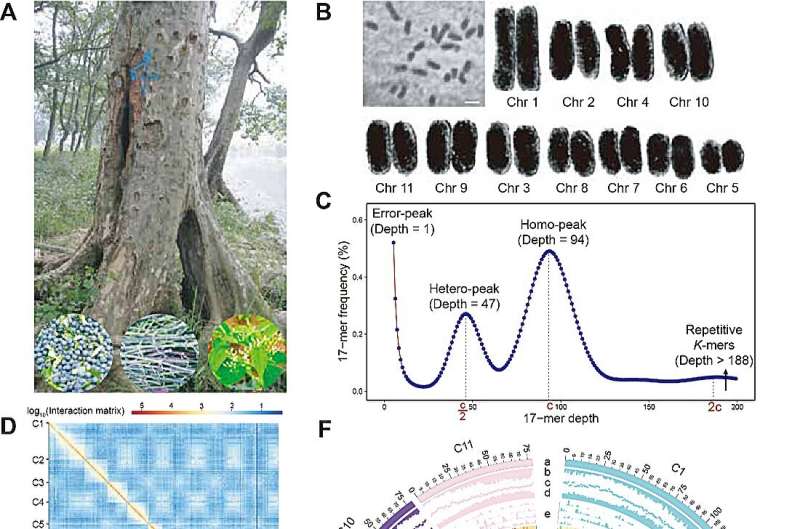This article has been reviewed according to Science X's editorial process and policies. Editors have highlighted the following attributes while ensuring the content's credibility:
fact-checked
peer-reviewed publication
trusted source
proofread
Chinese team completes the genome assembly of Cornus wilsoniana

Cornus wilsoniana (2n=22) is a common shrub in the northern temperate zone of China. It blooms white flowers in spring and produces purple-black berries in autumn. This tree has a unique mottled bark texture that makes it particularly eye-catching in winter, earning it the common name "ghost dogwood." Due to its peeling bark in winter, it is commonly known as "Guangpi tree" in China.
The fruit of C. wilsoniana is rich in oil and can be used to extract edible oil. The oil content of the fruit can reach up to 55% and contains abundant unsaturated fatty acids. Compared to other edible oils, it has hypolipidemic effects. Therefore, the fruit oil of C. wilsoniana can not only serve as a well-balanced dietary oil, but also helps control blood lipids.
Meanwhile, owing to its strong stress resistance, it can play a huge role in afforestation, sand-fixation and soil conservation.
In September 2023,Horticulture Research published an article titled "A chromosome-level genome assembly provides insights into Cornus wilsoniana evolution, oil biosynthesis and floral bud development," which was completed by the collaboration of Prof. He Zhenxiang, Prof. Dijun Chen, Prof. Ming Chen and Prof. Liangbo Zhang's group.
This study accomplished the chromosome-level genome assembly of C. wilsoniana, laying the foundation for evolutionary analysis and genetic research of key traits in this species.
This study obtained the chromosome-level genome sequence of C. wilsoniana using PacBio HiFi and Hi-C sequencing technologies. The genome size is about 843.51 Mb, with a contig N50 of 4.49 Mb and scaffold N50 of 78.00 Mb.
A total of 30,474 protein-coding genes were annotated. Comparative genomics analysis identified that the genome of C. wilsoniana has experienced one whole genome triplication event (WGT-γ, 115.86 Mya) and one whole genome duplication event (WGD, 44.90 Mya).
The researchers also explored the origin of C. wilsoniana chromosomes and reconstructed its karyotype evolution history.
Collinearity analysis revealed that C. wilsoniana shares similar genome structures with C. controversa (2n=20), and they both belong to the genus Cornus in the Cornaceae family, completing divergence about 12.46 Mya.
Transcriptomic analysis found that FAD2 gene family members play a key role in regulating the oleic to linoleic acid ratio in C. wilsoniana oil. Additionally, 33 MADS transcription factor genes highly correlated with the flowering process of C. wilsoniana were identified by transcriptomic and metabolomic techniques.
This research provides valuable resources for germplasm innovation and genetic improvement of C. wilsoniana.
More information: Zhenxiang He et al, A chromosome-level genome assembly provides insights into Cornus wilsoniana evolution, oil biosynthesis and floral bud development, Horticulture Research (2023). DOI: 10.1093/hr/uhad196
Journal information: Horticulture Research
Provided by NanJing Agricultural University





















